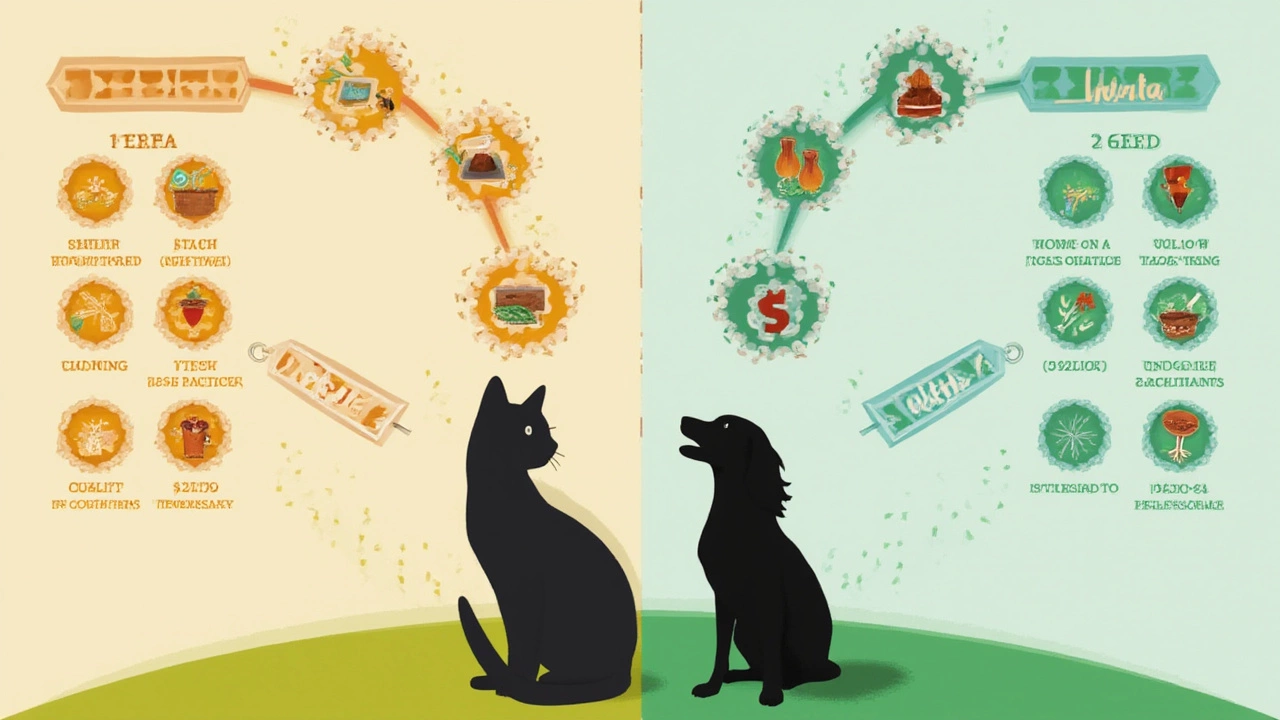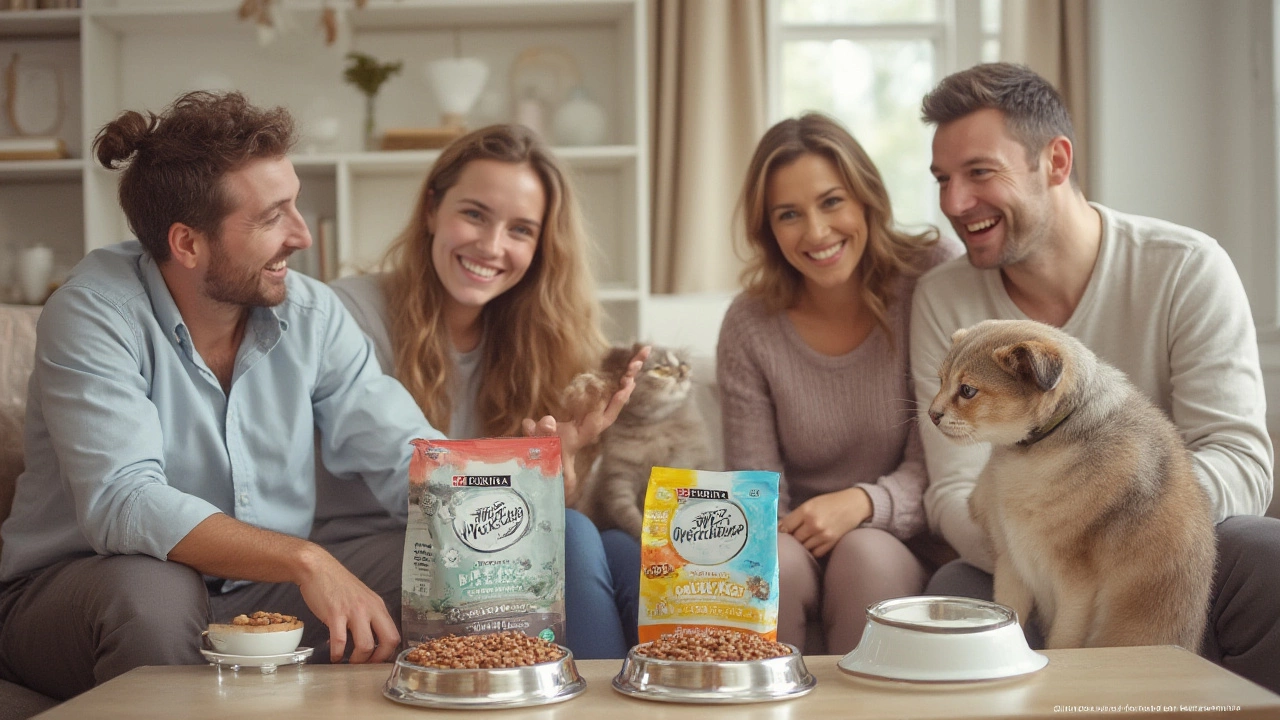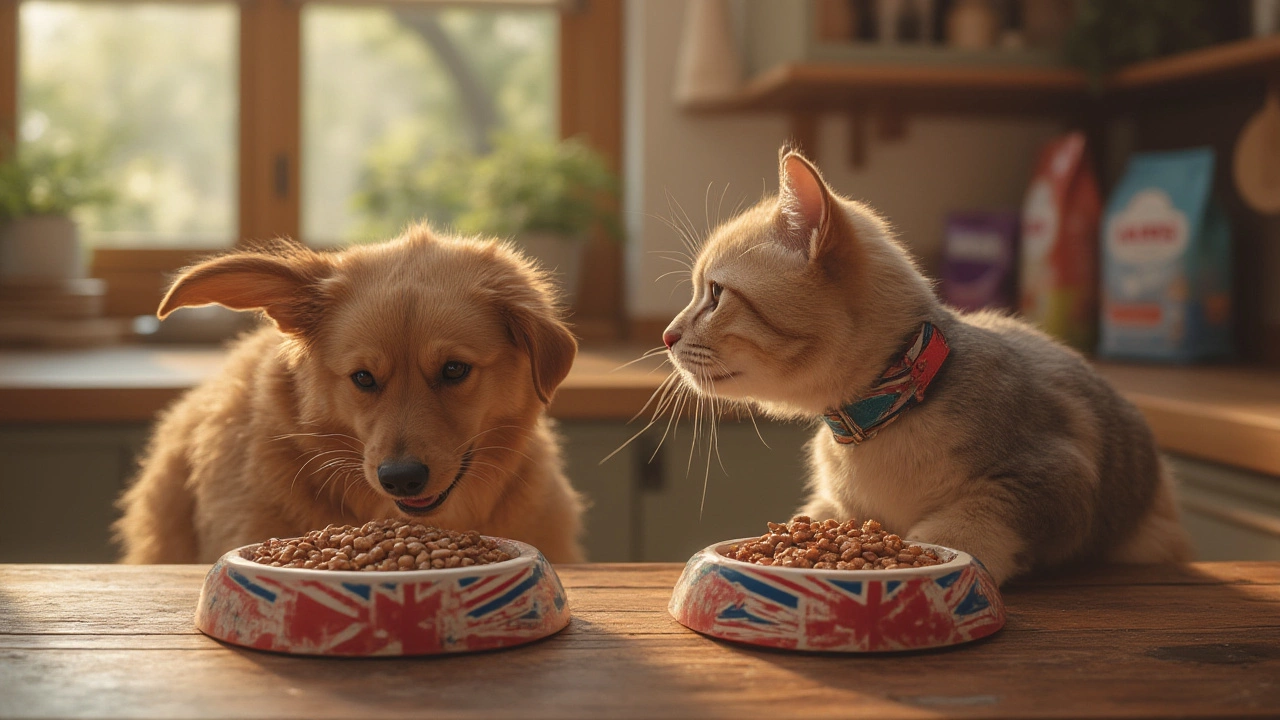Walk into any pet food aisle and you’ll be bombarded by shiny packaging and promises of happy, healthy pets. Purina and IAMS stand at the front of the crowd, each boasting generations of pet parents who swear by them. The stakes feel pretty high—especially when every meal shapes your cat or dog’s well-being. It’s not just what’s cheapest or most popular. The right food can actually mean fewer vet trips, more playtime, and a shinier coat. So, does Purina really top IAMS, or is it the other way around?
Brand Histories and Trust: Decades of Furry Fans
Both Purina and IAMS look back on decades of feeding pets, but their journeys couldn’t be more different. Purina sprang up way back in 1894 in St. Louis, Missouri. The brand didn’t just sit still—they were the first to bring out dry dog food in 1956. Their slogans, "Your Pet, Our Passion," start to sound pretty convincing once you see their investments in pet nutrition research. You’ll find Purina behind a stack of products like Purina Pro Plan, ONE, Fancy Feast, and Friskies. Not all their labels claim the same things, but just know the variety is endless.
IAMS launched in 1946, not far from Purina’s American roots. Paul Iams, the founder, wanted to shake up pet nutrition with higher-quality meat proteins. Now, IAMS is a household name, owned by Mars Inc., the chocolate bar giant that also runs Pedigree and Whiskas. This isn’t some faceless lab—these brands spend tons on nutritional research, too. If you grew up with a pet, there’s a decent shot you poured out one of these brands for breakfast.
Both have doggedly (pun intended) earned awards and recognition in the pet food space. Take Purina’s 500+ global scientists and veterinarians, or the IAMS nutritionists working behind the scenes. Purina won the 2022 Pet Food Brand of the Year in a USA shopper survey. IAMS often shows up as a "best value" on consumer advocacy platforms like the Good Housekeeping Institute. Consistency and effectiveness seem to be their loyalty magnets—as well as that familiar look on store shelves worldwide.
Still, here’s where brand trust deserves some thought: both brands have faced recalls. Purina has had the odd recall, though far less frequently than some rivals. IAMS dealt with a few, usually for reasons like salmonella risk or a vitamin issue. Safety recalls are more common in this industry than you’d expect—so keeping up with them matters if safety is your big concern. Food and safety agencies in the US and New Zealand both keep active recall lists, and you can sign up for alerts so nothing slips under the radar.
What’s Really in the Bag: Ingredient Quality Unwrapped
Flip over that food bag, and the ingredient list can feel like a chemistry test. But it matters—so much. Everything in your pet’s bowl needs to fuel their energy, coat, digestion, and long-term health.
Purina shines when it comes to variety. Their lower-tier lines (like Dog Chow or Cat Chow) use basic grains like corn, wheat, and soy. It’s not all bad—grains can give dogs carbs for energy—but for digestive troubles or allergies, grains can be a deal-breaker. Purina Pro Plan and Purina ONE up the ante with real meat—chicken, lamb, turkey, sometimes salmon—as the first ingredient. Cat owners often spot taurine in the list, which cats need for heart health. Some Purina formulas add omega-3 and 6 fatty acids, handy for joint and coat care. They’ve got grain-free lines, but not every product fits the grain-free label.
IAMS keeps things meat-focused too. You’ll often see named meat or meat meal (like "chicken" or "lamb meal") as the first ingredient—never just "meat by-product." Some dog and cat parents love that transparency. Their ProActive Health line touts prebiotics for digestion and no artificial preservatives or flavors. Across both brands, vitamin supplementation is standard. You’ll typically find zinc, selenium, and vitamins A, D, and E, because dog and cat bodies need more than meat alone. Cats get extra taurine and sometimes fiber for hairball control. Just watch for corn, soy, and wheat in IAMS’ budget lines if food allergies are an issue.
Looking closer at ingredient standards, both brands meet or exceed AAFCO (Association of American Feed Control Officials) guidelines, which dictate minimum nutrition. Still, "by-products" and "meals" get a bad rap, but they don’t necessarily mean unhealthy. In fact, "chicken meal" is just dehydrated, protein-packed meat. If you prefer whole-ingredient simplicity, both have options at a premium—like Purina Pro Plan Sensitive Skin & Stomach or IAMS Healthy Naturals.
| Comparison | Purina Pro Plan | IAMS ProActive Health |
|---|---|---|
| Main Protein | Chicken, lamb, or salmon as the top ingredient | Chicken or lamb as the top ingredient |
| Carb Sources | Corn, rice, soy, wheat (varies by product) | Corn, barley, sorghum (varies by product) |
| Specialty Options | Grain-free, sensitive digestion, weight control | Sensitive digestion, weight control, senior recipes |
| Additives | Vitamins, minerals, Omega-3, fiber for digestion | Vitamins, minerals, omega fatty acids, prebiotics |
Sometimes tricky terms pop up—like "animal digest" (a flavoring, not a mystery meat) or "meat by-product" (things like hearts and livers, packed with nutrients). It’s worth knowing that, by law, pet food in New Zealand and much of the world can’t contain anything unsafe or diseased. And, yes, the law is clear: "The main priority should be that all ingredients are safe and provide nutritional benefits," notes the NZ Pet Food Manufacturers Association.

Price Tag vs. Pet Health: Does Paying More Win?
Pet food isn’t cheap, especially if you have a Labrador as hungriest as my Max. Prices swing wildly even inside these brands. You’ll find Purina’s budget lines in supermarkets at a price that keeps wallets happy—think under $3 a kilo. Their Pro Plan formulas, often sold at vets or specialty stores, might go for double or triple that. IAMS positions itself a touch above budget, usually by a dollar or two per kilo more than entry-level Purina. Premium IAMS foods can match Purina’s high-end lines in cost.
But the million-dollar question: do pricier bags mean healthier pets? Studies, like a 2023 report by the Pet Food Institute, reveal that nutritionally complete, meat-first dry food usually offers better digestibility and fewer fillers. Dogs and cats eat less, poop less, and energetic pups need smaller daily servings. My own Max’s vet pointed out that better ingredients often keep coats shiny and reduce stinkier dog breath (talking from my living room, not a lab!).
A budget cat or dog food, whether from Purina or IAMS, still meets basic nutrition standards. You likely won’t see dramatic problems, especially if your pet is healthy. Where things get interesting is with special needs—like allergies, sensitive tummies, or older pets slowing down. Here, the premium blends feel worth the splurge. Think joint support, higher protein for muscle mass, or added glucosamine for seniors. These tweaks can mean fewer supplements and vet visits, if you believe the stories from devoted buyers (and the odd vet’s nod).
Still, price doesn’t always reflect direct quality. Fancy branding, extra marketing, or trendy claims can bump up the cost. The safest move? Match your pet’s life stage and health needs to a food’s nutrition label—not just what’s new or shiny on the shelf. Ask your vet before paying extra for a "premium" label, especially if your pet is thriving on their current fuel. For owners who buy in bulk, look for deals at vet practices or animal supply stores, which often run specials or loyalty points.
Real Results: Health, Taste, and Everyday Experience
A bag could read like poetry, but the true test is your pet’s reaction. My dog Max goes nuts for chicken-based Purina Pro Plan, but I know cats who only sniff at IAMS Lamb & Rice. Every animal’s taste buds are different, so don’t be surprised if your pet turns up their nose at your first pick.
Palatability—how much pets actually want to eat the food—can change everything. Purina has invested in flavor research, running blind taste tests with panels of dogs and cats (living out every pet owner’s dream job). They tweak kibble shapes and flavors until most pets gobble it up. IAMS isn’t far behind; their consistency usually makes it to the bowl every time. For fussy eaters, wet food or toppers from either brand can spark new excitement at mealtime.
Energy levels, coat glossiness, digestion—these are the daily "results" pet parents judge. Purina Pro Plan gets great marks for pets with food sensitivities. Customers comment on shinier coats, firmer stools, and fewer allergy flare-ups. IAMS ProActive Health, especially the Sensitive Digestion line, can work wonders for gassy, bloat-prone pups or cats battling hairballs. Their inclusion of prebiotics and beet pulp keeps digestion running smoother for most pets. Cats prone to urinary troubles have special formulas in both brands, focusing on mineral balance to reduce kidney stress.
Some pets are, of course, natural contrarians—don’t be discouraged if your own fluffy rebel refuses what works for your neighbor’s pooch. Gradual transitions work best: sprinkle a little of the new food into their old blend, slowly dialing it up over a week. This limits stomach upset and gives both you and your pet a chance to judge any changes in poop quality, coat shine, or energy.
On allergies, both brands have grain-free, single-protein, and prescription-only formulas (like Purina Veterinary Diets or IAMS Veterinary Formula). These aren’t just for show—some pets need strictly controlled diets for real health reasons. Always go through your vet for these products—they’ll run allergy tests or elimination diets to make sure your choice helps, not hurts.
"Most healthy adult pets will do well on either brand if you match the product to their life stage and needs. Premium blends can make a visible difference for pets with sensitivities or seniors starting to slow down," says Wairarapa-based vet Dr. Nikki Turner, who’s seen hundreds of pets try both brands.
Long-term, it’s smart to watch for any signs of food-related trouble. Excess shedding, frequent itching, hot spots, or loose stool can all be food-related. If you spot something off, swap flavor or formula and track for improvements. Sometimes, you’ll need to try two or three options to land on a winner.

Which Should You Pick? Easy Steps to Your Perfect Pet Food Match
If you’re standing in front of that shelf, totally baffled, let’s break it down into less stressful steps. First, jot down your pet’s health quirks: allergies, age, activity level, and size. Are they a food hoover (like Max!), or do they chomp a few mouthfuls and wander off? Next, check your budget—are you shopping big bags or picking up tins with each grocery run?
- Choose Purina if you need a wider range. They offer more recipes, flavors, and budget-to-premium levels. Cats with hairballs, dogs with itchy skin, or picky eaters get stacks of options. If your pet likes variety—or if you have multiple animals with different needs—Purina likely has a solution.
- Pick IAMS if clear meat-first recipes matter most, and you like a tight, straightforward product line. Their formulas, especially in the ProActive Health range, appeal to pets with sensitive tummies and active lifestyles. Their smaller product range means switching flavors is easier without losing key nutritional balances.
- If your pet’s never had allergies, consider a grain-inclusive recipe for cost savings. Grains aren’t the enemy unless your animal reacts badly. But for high-energy working dogs or cats with wheat issues, grain-free lines (available from both brands) can be game-changers.
- If you’re concerned about recalls and ingredient safety, sign up for your country’s recall notifications and check each brand’s recent food history. Vets often keep lists of safe, trusted formulas and will tell you what’s currently reliable.
- If taste-testing is key, buy the smallest bag or pouch possible. Split meals between brands for a week, and see which bowl empties first. Your pet’s excitement is sometimes the real expert opinion.
Remember—there’s no absolute "best brand" for every pet. Both Purina and IAMS stack up well for essential nutrition, taste, and safety. Pick the product that matches your pet’s specific needs instead of just chasing labels. And if you’re ever lost? Ask your vet, the person at your favorite rescue, or any obsessed pet owner in the dog park—they’ll share stories, swaps, and what keeps their animals energetic and happy.
At home in Auckland, Max is thriving on a Purina Pro Plan—shiny fur, clean teeth, and more energy than I sometimes want. But I’ve seen cats thrive on IAMS for decades, too. Your best bet is the bowl that matches your pet, your budget, and the little grin you get at breakfast time. Isn’t that what we’re all aiming for?
